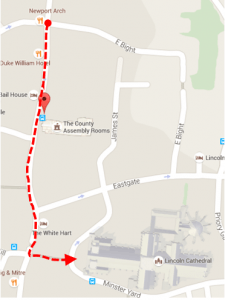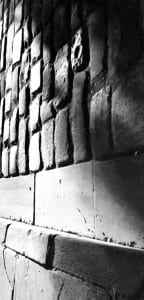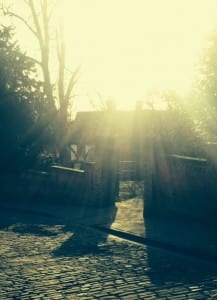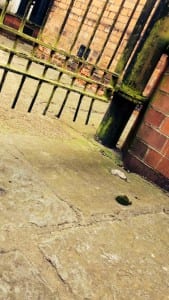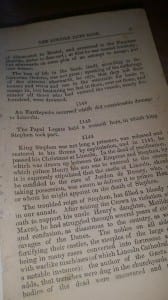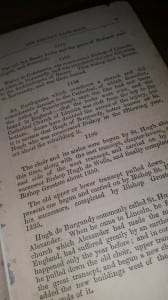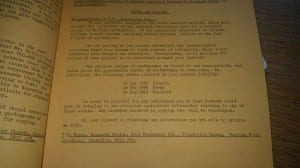Framing Statement
“Theatre has a long history of experimentation with a variety of spatial configurations and relationships, but it is only in the last two decades that the label `site-specific’ has been applied to theatrical performance” (Wilkie, 2004). The Site that our group was assigned was the uphill area of Lincoln. When we eventually got into groups we came up with a list of possible ideas we wanted to explore.
Our ideas list included:
- Exploring the senses – Heightening and Blocking
- Using Audio, Video or picture documentation
- Abstract, concentrate on energy
- Cathedral (choir)
- Playing with heights
- RAF
- Pathways/footprints
- Video of site
- Subtle mob – video pin point participants
- History
- Suggestive
- Different experiences.
Once we had reflected on the list of our ideas we came to the decision to make an audio walk centring on the Cathedral, Castle Square and Bailgate. We were inspired by the works of Blast Theory performance Can you see me now?
“Along with Botfighters, Can You See Me Now? is one of the first location based games. Online players compete against members of Blast Theory on the streets. Tracked by satellites, Blast Theory’s runners appear online next to your player on a map of the city. On the streets, handheld computers showing the positions of online players guide the runners in tracking you down.
With up to 100 people playing online at a time, players can exchange tactics and send messages to Blast Theory. An audio stream from the runner’s walkie talkies allowed you to eavesdrop on your pursuers: getting lost, cold and out of breath on the streets of the city.
Can You See Me Now? is the second major collaboration with the Mixed Reality Lab at the University of Nottingham after Desert Rain. As well as winning the Prix Ars Electronica this work was nominated for a BAFTA in Interactive Arts. It was developed during a long period of research and development in London and Nottingham exploring Global Positioning Systems and wireless networking. Steve Benford, Martin Flintham and Rob Anastasi from the Lab made particularly significant contributions to this work.”(Blast Theory,2015)
We also took inspiration from our own tutors theatre group Proto-type’s through the wall Site installation.
“Through the Wall was a six channel video and poetic audio installation commissioned by Chester Performs for the Up The Wall arts festival.
Sited on the Roman Walls within the Roman Gardens, Through the Wall was inspired by the surface of the Chester walls and by the (metaphorical) potential of re-orienting the flow of movement through and into the history of the walls.
At three sites in the Roman Gardens, projections on both sides of the wall looped and linked, showing three wanderers moving from one frame to another and stopping to look at the scenery of places that have a real or imagined link to the walls themselves” (Proto-type, 2015).
Adding the group’s interest of the 1185 Lincoln Earthquake we made this the centre of our audio walk and aimed to create a disturbance in a place which is normally quiet and unexciting. Hence why we named our piece Disturbance.
“I’ve always been interested in the creation of physical narratives which take the place of words.”(Cousin, 1994) like Pearson’s answer in Geraldine Cousin’s interview in 1994 our group liked the idea of using something different to replace words to portray the disaster of 1185. Replacing A full spoken narrative we use sound and minimal spoken narrative to portray our piece “the use of technology does not efface the initial medium of the physical performer; rather photos, video and audio recordings maintain, multiply, moderate and even heighten some of the qualities of the performer’s presence.”(Nedelkopoulou, 2011) agreeing with this statement the group thought this would strengthen our performance and the idea to portray this disaster through an audio walk would be the most efficient way.
These ideas then led to our final performance which lasted 11 minutes and 15 seconds and followed a route in the uphill area of Lincoln on the 6th May 2015. The audience would arrive at a point just past Newport arch and follow the route (below) while listening to the audio (below) we made and provided. The participants not only acted as an audience but also a performer as the way they acted and reacted also was a performance in its own right.
https://soundcloud.com/george-murphy…/disturbance-audio-walk
Analysis of Process
During one of our sessions at the beginning of the process involved the group being led on a tour of the uphill area of Lincoln. We discovered the places that could be possible site performance areas. Whilst on the tour I began to collate different elements to make my idea which I would like to expand upon for my performance. My idea is to work with the perspective of the uphill ‘world’ through heightened senses. When reviewing my photos after the tour some of them inspired me to maybe use photography to portray different feelings or edit them in such a way (like the experimental ones below) to show what partially sighted, colour blind and disabled people may see or to maybe portray different emotions/feelings such as awe, wonder, hopelessness or confusion.
Once in groups my idea changed but the idea of keeping the performance an audio stayed. We were inspired by Blast Theory and there performance Can you see me now? And we particularly focused on the element of “exposition of virtual and physical modes of engagement in Can You See Me Now? That inspires a critical reflexivity on physical participation in the contemporary cultural landscape, where technology and virtual reality become progressively dominant ways of mediating reality.” (Woycicki,2014). We took this idea from Blast Theory and combined it the history that surrounds the uphill area of Lincoln and merge them into two audio tours. One would take the route of Heaven and the other hell. After presenting our idea to Rachael she made valid points about our idea not being appropriate and generic so we retreated to a coffee shop and conducted a group meeting to see if we could keep the structure but change the ‘flesh’ of the idea. “Within this social climate, performance has acquired significance in framing and reframing places and spaces as the changing routes and roots of communities, and individuals are negotiated, questioned and explored.” (Govan, Nicholson and Normington, 2007) bearing this in mind we did some more research into the history of Lincoln and later came up with the idea of war/RAF and also discovered the 1185 earthquake that hit Lincoln and cause extensive damage to the Cathedral. So we thought by only using audio and a map we could create a soundscape of both scenarios and leaving the listener to make up their own mind about what they are hearing and what it might be based on.
Throughout the weeks we have been developing the idea of our split audio walk, experimenting with different routes, sound, ways for the listener to know where to walk to ect as “Spatial relationships have always been integral to performance- making; the configuration of performance spaces and their effect on actor-audience exchanges have been richly and variously investigated by practitioners across histories and cultures.” (Govan, Nicholson and Normington, 2007) (Audio – RAF)
We then presented this idea to Conan and Rachael this was quite daunting we received good feedback such as:
- The history of the RAF is in Lincoln/Lincolnshire and has no direct ties to the uphill area of Lincoln
- The idea of the earthquake and making more of that could be something to expand on
- Scrap the idea of split audio walk as each listener will have a different experience with just on tour
This aided us alter our idea, for the better and simplify and define our idea. Conan was particularly interested in the idea of the Earthquake and said to look behind the science and history of earthquakes and concentrate on that. Rachael also mentioned Janet Cardiff, “Janet Cardiff has been developing and devising her audio and video walks since 1991.”(Nedelkopoulou, 2011)
Aided with a new idea route Me, Elizabeth and George decided to go to the Lincoln Central Library archives the following Monday. Our time Lincoln Central Library Archives was central to our process. The people in there where more than happy to help and presented us with more than 10 things to helps us on our quest for information. We found that in several books there was only a line of information about the earthquake – Below are picture of the books we found on the earthquake but no more could be found.
After looking for an hour we came across a letter (Below) sent out by a man looking for more information on the earthquake and he had a date book which took us down various different routes and brought up some things of interest we are looking to use in our piece.
We met with the rest of the group to share the new information we had gathered and began to talk about plotting our routes and what our audio was going to sound like and what we may include. We had decided to make it about twenty minutes long and that based on the books we read our route will have a significance and not be an idle wonder as Cardiff says “Walking is very calming. One step after another, one foot moving into the future and one in the past. Did you ever think about that? Our bodies are caught in the middle. The hard part is staying in the present. Really being here. (Cardiff 2004: Her Long Black Hair)” (Nedelkopoulou, 2011) so we had to think about our route and what the significance of I would be and a good reasoning behind it. Easter was in the week commencing so we set a plan and hope to fulfil it by the end of Easter.
Roles:
Jade- Routes and Research
Elizabeth- Routes and Research
Jess – Marketing
George – Audio
Me – Audio
By the end of the Easter holidays we plan to have a solid route and our reasoning
After Easter we had a route planned (Below) and an audio in process. We didn’t meet up in Easter as much as we had like so fell behind a little bit but in the week after Easter mange to pick back up. We kept sharing ideas to add to our audio and some of us would go out a record in the site for material we could possibly use within the audio.
With the rough audio done (Link – https://www.youtube.com/watch?v=GXUbt03RO0Q&feature=youtu.be) we decided to book a meeting with our tutor Rachael and give it a test run with her and get feedback on anything we needed to improve. After she completed our route with the audio she met back with us to give us her opinion on it and tell us any changes we could make to improve it. She loved the end moment which we very pleased with as this was our biggest challenge. Rachael also pointed out to us that even though she like the walk it was too short and she was standing at the Cathedral for too long and to maybe consider add things into our audio that would make people stop to extend the time they spend on the walk to allow them to end up at the cathedral at the right time. Finally she told us to add things such to build up to the final moment and to think about why we started at Newport arch and finished at Exchequer gate and find the significance in that in relation to our audio walk.
After taking into consideration the feedback we received from our tutor we edited and tweaked our audio accordingly and was happy with the finished product. We again booked a meeting with Rachael and this was our dress rehearsal before the performance day. Rachael then went on the route with the audio (Link –https://soundcloud.com/george-murphy…/disturbance-audio-walk) and came back and gave us feedback and suggested to us we should consider making the route longer as she was still standing at the Cathedral too long. The route stayed the same but we asked at the beginning of the tour for people to walk at a slow pace and to wonder around castle square before going through Exchequer gate. We also decide to have Elizabeth at the beginning of the walk to give a little ‘speech’ about the walk before the participants went away. My post was to stand near the Cathedral and be there if anyone wanted to ask any questions. The rest of the group was dotted around the route just in case people experienced difficulties. Below is Elizabeth and my speech:
Elizabeth – “The most famous Roman remain in Lincoln and the best preserved dates to the start of the 2nd century AD. It’s the only Roman arch still in use for daily transportation. In 1964 a lorry passed through the central arch dislodging bits of the arch way. (Beat) If you follow the path under Newport arch and follow the path along until you get to castle square. Turn left they will come to Exchequer gate where tenants who rented from the church came to pay their rent. Built in the 14th century it acted as the main ceremonial access point to the Cathedral close. Along the route if you experience any trouble there are fellow group members wearing headphones, so if remove your headphones they will approach you and help. At the end you will see a Kia standing near cathedral wearing headphones and a black and white chequered coat if you have every further questions.”
Kia – “Thank you for taking part today if you have any further question feel free to ask me or message us on Facebook and survey will be sent to everyone who participated today”
Performance Evaluation
Our audio walk did not attract much interest as the day of our performance there was bad weather which deferred people coming as it took place outside. We had three people complete our audio walk and then two assessor who participated as well. The feedback we received was good and included comments such as:
- The end moment was fantastic
- It was something different
- I didn’t really get it but I enjoyed it
The uphill area of Lincoln is rich with history which inspired me to explore and there can be endless performances that could branch off this and considering the thriving environment it is today there are other opportunities for performance as well. Although apathetic towards site-specific performance I still would be interested in exploring and possibly creating another performance contrary to the ‘Disturbance’ piece and see the difference in experience, as I had an unpleasant experience performing my ‘Disturbance’ piece.
During our final performance there are a few things I would have improved and altered to make the audio walk better. The reasons being:
- Making the Route longer
- Break up the audio with some information linking to audio
- Better communication between members of the group
- Adding the information/speeches Me and Elizabeth had to the audio rather than us stand outside
- Give the participants the route before hand
- Build up the final moment
- Better recording of the audio
“All of Cardiff and Miller’s walks are recorded in ‘binaural’ audio to create a three dimensional reproduction of sound. According to this technique, the recording system is based on the use of two miniature microphones placed in the ears of a dummy head, so that the sound is captured in the way that a person would ordinarily hear it (Janet Cardiff and George Bures Miller, Walks).” (Nedelkopoulou, 2011). If my group had a longer rehearsal time we could take the pervious statement and put it into practice and use this method recording the audio “following the same route as their potential participants” (Nedelkopoulou, 2011).
As mentioned previously, although apathetic toward site-specific performance it has changed my perception of traditional theatre and allowed me to expand my knowledge in something I wouldn’t otherwise consider exploring. It has taught me how to perform within a non-traditional setting and the challenges that come with it, such as:
- Public Disturbance
- Weather conditions
- Various health and safety issues
Overall I learned information and expiernced something different that will help me in the theatre ‘world’ whether I chose to go into this genre of theatre or chose to use elements of knowledge or performance techniques in any devised piece I may do in the future. Although this module of my course was not an area that I was interested in as other areas, I feel the experience gained has been valuable.
Bibliography
Blasttheory.co.uk, (2013). Can You See Me Now? | Blast Theory. [online] Available at: https://www.blasttheory.co.uk/projects/can-you-see-me-now/ [Accessed 14 May 2015].
Cousin, G. (1994). An Interview with Mike Pearson of Brith Gof. Contemporary Theatre Review, 2(2), pp.37-47.
Govan, E., Nicholson, H. and Normington, K. (2007). Making a performance. London: Routledge
Nedelkopoulou, E. (2011). Walking Out on Our Bodies Participation as ecstasis in Janet Cardiff’s Walks. Performance Research, 16(4), pp.117-123.
Proto-type.org, (2015). Proto-type. [online] Available at: http://proto-type.org/ [Accessed 13 May 2015].
Wilkie, F. (2004). Out of Place The Negotiation of Space in Site-Specific Performance. Ph.D. University of Surrey.
Woycicki, P. (2014). A critical study of physical participation in Blast Theory’s Can You See Me Now ?. International Journal of Performance Arts and Digital Media, 10(2), pp.193-204.

